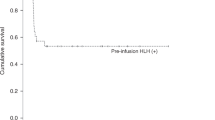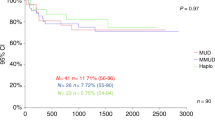Abstract
Graft failure (GF) is a significant complication after allogeneic hematopoietic stem cell transplantation (HCT) and is associated with a high mortality rate. We performed re-transplantation using haploidentical-related donors to rescue children with early GF. Between 2008 and 2013, 10 patients received re-transplantation from haploidentical family donors. The median age at HCT was 13.5 years and the median time between transplantations was 52.5 days. Conditioning regimen with fludarabine and CY was used in seven patients, and TBI was added in three patients. All 10 patients received T-cell-depleted grafts using CD3 or CD3/CD19 MoAb. The median numbers of CD34+ and CD3+ cells were 5.52 × 106/kg and 1.08 × 106/kg, respectively. For GVHD prophylaxis, mycophenolate mofetil (MMF) and tacrolimus or MMF and CYA were used. All 10 patients achieved a sustained neutrophil engraftment and maintained a complete donor chimerism at the time of analysis (median 23 months, range 6–62 months). Nine of 10 patients were alive, and one patient with moyamoya disease with AML died of encephalopathy 7 months post transplant. This study suggests that fludarabine- and CY-based conditioning with T-cell-depleted haploidentical HCT is a feasible option to rescue pediatric patients with primary GF.
This is a preview of subscription content, access via your institution
Access options
Subscribe to this journal
Receive 12 print issues and online access
$259.00 per year
only $21.58 per issue
Buy this article
- Purchase on Springer Link
- Instant access to full article PDF
Prices may be subject to local taxes which are calculated during checkout



Similar content being viewed by others
References
Anasetti C, Amos D, Beatty PG, Appelbaum FR, Bensinger W, Buckner CD et al. Effect of HLA compatibility on engraftment of bone marrow transplants in patients with leukemia or lymphoma. New Engl J Med 1989; 320: 197–204.
Laughlin MJ, Eapen M, Rubinstein P, Wagner JE, Zhang MJ, Champlin RE et al. Outcomes after transplantation of cord blood or bone marrow from unrelated donors in adults with leukemia. New Engl J Med 2004; 3512: 2265–2275.
Powles RL, Morgenstern GR, Kay HE, McElwain TJ, Clink HM, Dady PJ et al. Mismatched family donors for bone-marrow transplantation as treatment for acute leukaemia. Lancet 1983; 12: 612–615.
Davies SM, Weisdorf DJ, Haake RJ, Kersey JH, McGlave PB, Ramsay NK et al. Second infusion of bone marrow for treatment of graft failure after allogeneic bone marrow transplantation. Bone Marrow Transplant 1994; 141: 73–77.
Waki F, Masuoka K, Fukuda T, Kanda Y, Nakamae M, Yakushijin K et al. Feasibility of reduced-intensity cord blood transplantation as salvage therapy for graft failure: results of a nationwide survey of adult patients. Biol Blood Marrow Transplant 2011; 17: 841–851.
Yoshihara S, Ikegame K, Taniguchi K, Kaida K, Kim EH, Nakata J et al. Salvage haploidentical transplantation for graft failure using reduced-intensity conditioning. Bone Marrow Transplant 2012; 47: 369–373.
Lang P, Mueller I, Greil J, Bader P, Schumm M, Pfeiffer M et al. Retransplantation with stem cells from mismatched related donors after graft rejection in pediatric patients. Blood Cell Mol Dis 2008; 403: 33–39.
Im HJ, Koh KN, Choi ES, Jang S, Kwon SW, Park CJ et al. Excellent outcome of haploidentical hematopoietic stem cell transplantation in children and adolescents with acquired severe aplastic anemia. Biol Blood Marrow Transplant 2013; 19: 754–759.
Glucksberg H, Storb R, Fefer A, Buckner CD, Neiman PE, Clift RA et al. Clinical manifestations of graft-versus-host disease in human recipients of marrow from HL-A-matched sibling donors. Transplantation 1974; 18: 295–304.
Przepiorka D, Weisdorf D, Martin P, Klingemann HG, Beatty P, Hows J et al. Consensus conference on acute GVHD grading. Bone Marrow Transplant 1995; 15: 825–828.
Doney KC, Weiden PL, Storb R, Thomas ED . Treatment of graft-versus-host disease in human allogeneic marrow graft recipients: a randomized trial comparing antithymocyte globulin and corticosteroids. Am J Hematol 1981; 11: 1–8.
Storb R, Prentice RL, Sullivan KM, Shulman HM, Deeg HJ, Doney KC et al. Predictive factors in chronic graft-versus-host disease in patients with aplastic anemia treated by marrow transplantation from HLA-identical siblings. Ann Intern Med 1983; 98: 461–466.
Guardiola P, Kuentz M, Garban F, Blaise D, Reiffers J, Attal M et al. Second early allogeneic stem cell transplantations for graft failure in acute leukaemia, chronic myeloid leukaemia and aplastic anaemia. French Society of Bone Marrow Transplantation. Br J Haematol 2000; 111: 292–302.
Bethge WA, Haegele M, Faul C, Lang P, Schumm M, Bornhauser M et al. Haploidentical allogeneic hematopoietic cell transplantation in adults with reduced-intensity conditioning and CD3/CD19 depletion: fast engraftment and low toxicity. Exp Hematol 2006; 34: 1746–1752.
Muller S, Schulz A, Reiss U, Schwarz K, Schreiner T, Wiesneth M et al. Definition of a critical T cell threshold for prevention of GVHD after HLA non-identical PBPC transplantation in children. Bone Marrow Transplant 1999; 24: 575–581.
Chan KW, Grimley MS, Taylor C, Wall DA . Early identification and management of graft failure after unrelated cord blood transplantation. Bone Marrow Transplant 2008; 42: 35–41.
Grandage VL, Cornish JM, Pamphilon DH, Potter MN, Steward CG, Oakhill A et al. Second allogeneic bone marrow transplants from unrelated donors for graft failure following initial unrelated donor bone marrow transplantation. Bone Marrow Transplant 1998; 21: 687–690.
Ogawa H, Ikegame K, Yoshihara S, Kawakami M, Fujioka T, Masuda T et al. Unmanipulated HLA 2-3 antigen-mismatched (haploidentical) stem cell transplantation using nonmyeloablative conditioning. Biol Blood Marrow Transplant 2006; 12: 1073–1084.
Storb R, Pepe M, Anasetti C, Appelbaum FR, Beatty P, Doney K et al. What role for prednisone in prevention of acute graft-versus-host disease in patients undergoing marrow transplants? Blood 1990; 76: 1037–1045.
Huo MR, Xu LP, Li D, Liu DH, Liu KY, Chen H et al. The effect of HLA disparity on clinical outcome after HLA-haploidentical blood and marrow transplantation. Clin Transplant 2012; 26: 284–291.
Fleischhauer K, Zino E, Mazzi B, Sironi E, Servida P, Zappone E et al. Peripheral blood stem cell allograft rejection mediated by CD4(+) T lymphocytes recognizing a single mismatch at HLA-DP beta 1*0901. Blood 2001; 98: 1122–1126.
Wolff SN . Second hematopoietic stem cell transplantation for the treatment of graft failure, graft rejection or relapse after allogeneic transplantation. Bone Marrow Transplant 2002; 29: 545–552.
Kato M, Matsumoto K, Suzuki R, Yabe H, Inoue M, Kigasawa H et al. Salvage allogeneic hematopoietic SCT for primary graft failure in children. Bone Marrow Transplant 2013; 48: 1173–1178.
Martin PJ, Akatsuka Y, Hahne M, Sale G . Involvement of donor T-cell cytotoxic effector mechanisms in preventing allogeneic marrow graft rejection. Blood 1998; 92: 2177–2181.
Westerhuis G, Maas WG, Willemze R, Toes RE, Fibbe WE . Long-term mixed chimerism after immunologic conditioning and MHC-mismatched stem-cell transplantation is dependent on NK-cell tolerance. Blood 2005; 106: 2215–2220.
Ciurea SO, de Lima M, Cano P, Korbling M, Giralt S, Shpall EJ et al. High risk of graft failure in patients with anti-HLA antibodies undergoing haploidentical stem-cell transplantation. Transplantation 2009; 88: 1019–1024.
Ciurea SO, Thall PF, Wang X, Wang SA, Hu Y, Cano P et al. Donor-specific anti-HLA Abs and graft failure in matched unrelated donor hematopoietic stem cell transplantation. Blood 2011; 118: 5957–5964.
Jabbour E, Rondon G, Anderlini P, Giralt SA, Couriel DR, Champlin RE et al. Treatment of donor graft failure with nonmyeloablative conditioning of fludarabine, antithymocyte globulin and a second allogeneic hematopoietic transplantation. Bone Marrow Transplant 2007; 40: 431–435.
Chewning JH, Castro-Malaspina H, Jakubowski A, Kernan NA, Papadopoulos EB, Small TN et al. Fludarabine-based conditioning secures engraftment of second hematopoietic stem cell allografts (HSCT) in the treatment of initial graft failure. Biol Blood Marrow Transplant 2007; 13: 1313–1323.
McCann SR, Bacigalupo A, Gluckman E, Hinterberger W, Hows J, Ljungman P et al. Graft rejection and second bone marrow transplants for acquired aplastic anaemia: a report from the Aplastic Anaemia Working Party of the European Bone Marrow Transplant Group. Bone Marrow Transplant 1994; 13: 233–237.
Deeg HJ, O'Donnell M, Tolar J, Agarwal R, Harris RE, Feig SA et al. Optimization of conditioning for marrow transplantation from unrelated donors for patients with aplastic anemia after failure of immunosuppressive therapy. Blood 2006; 108: 1485–1491.
Rocha V, Labopin M, Sanz G, Arcese W, Schwerdtfeger R, Bosi A et al. Transplants of umbilical-cord blood or bone marrow from unrelated donors in adults with acute leukemia. New Engl J Med 2004; 351: 2276–2285.
Jacobson CA, Turki AT, McDonough SM, Stevenson KE, Kim HT, Kao G et al. Immune reconstitution after double umbilical cord blood stem cell transplantation: comparison with unrelated peripheral blood stem cell transplantation. Biol Blood Marrow Transplant 2012; 18: 565–574.
Bunin N, Small T, Szabolcs P, Baker KS, Pulsipher MA, Torgerson T . NCI, NHLBI/PBMTC first international conference on late effects after pediatric hematopoietic cell transplantation: persistent immune deficiency in pediatric transplant survivors. Biol Blood Marrow Transplant 2012; 18: 6–15.
Eyrich M, Lang P, Lal S, Bader P, Handgretinger R, Klingebiel T et al. A prospective analysis of the pattern of immune reconstitution in a paediatric cohort following transplantation of positively selected human leucocyte antigen-disparate haematopoietic stem cells from parental donors. Br J Haematol 2001; 114: 422–432.
Meijer E, Slaper-Cortenbach IC, Thijsen SF, Dekker AW, Verdonck LF . Increased incidence of EBV-associated lymphoproliferative disorders after allogeneic stem cell transplantation from matched unrelated donors due to a change of T cell depletion technique. Bone Marrow Transplant 2002; 29: 335–339.
Landgren O, Gilbert ES, Rizzo JD, Socie G, Banks PM, Sobocinski KA et al. Risk factors for lymphoproliferative disorders after allogeneic hematopoietic cell transplantation. Blood 2009; 113: 4992–5001.
Acknowledgements
This study was supported by a grant (2011–0571) from the Asan Institute for Life Sciences, Seoul, Korea.
Author information
Authors and Affiliations
Corresponding author
Ethics declarations
Competing interests
The authors declare no conflict of interest.
Rights and permissions
About this article
Cite this article
Park, J., Koh, K., Choi, E. et al. Successful rescue of early graft failure in pediatric patients using T-cell-depleted haploidentical hematopoietic SCT. Bone Marrow Transplant 49, 270–275 (2014). https://doi.org/10.1038/bmt.2013.163
Received:
Revised:
Accepted:
Published:
Issue Date:
DOI: https://doi.org/10.1038/bmt.2013.163
Keywords
This article is cited by
-
Non-relapse cytopenias following allogeneic stem cell transplantation, a case based review
Bone Marrow Transplantation (2022)
-
Outcomes of salvage haploidentical transplantation using posttransplant cyclophosphamide for graft failure following allogeneic hematopoietic stem cell transplantation
International Journal of Hematology (2022)
-
Salvage HLA-haploidentical hematopoietic stem cell transplantation with post-transplant cyclophosphamide for graft failure in non-malignant disorders
Bone Marrow Transplantation (2021)
-
Non-myeloablative conditioning for second hematopoietic cell transplantation for graft failure in patients with non-malignant disorders: a prospective study and review of the literature
Bone Marrow Transplantation (2017)
-
Refinement of treatment strategies in ex vivo T-cell-depleted haploidentical SCT for pediatric patients
Bone Marrow Transplantation (2015)



